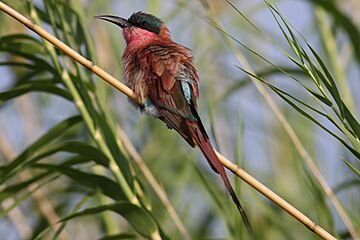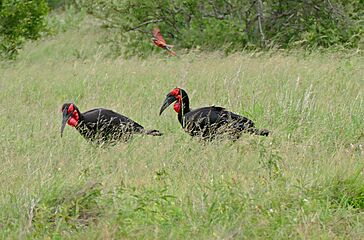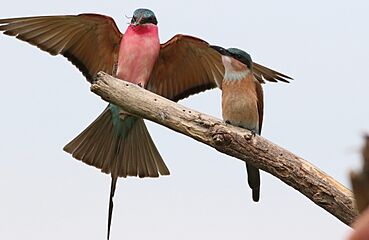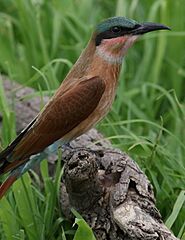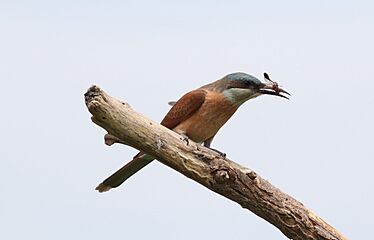Southern carmine bee-eater facts for kids
Quick facts for kids Southern carmine bee-eater |
|
|---|---|
 |
|
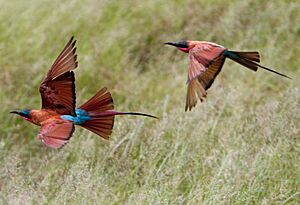 |
|
| Conservation status | |
| Scientific classification | |
| Genus: |
Merops
|
| Species: |
nubicoides
|
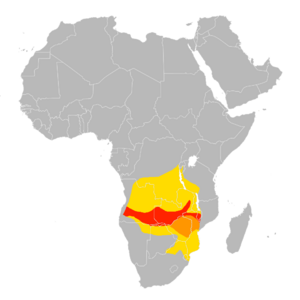 |
|
| Southern carmine bee-eater distribution map. Red colour – resident; orange – breeding; yellow – non-breeding. | |
The southern carmine bee-eater (scientific name: Merops nubicoides) is a beautiful bird found in many parts of southern Africa. It belongs to a group of birds called bee-eaters. This bird used to be thought of as the same species as the northern carmine bee-eater, but now scientists know they are different.
Contents
What Does It Look Like?
The southern carmine bee-eater is a very colorful bird! Most of its body is a bright, deep red color, like the color of a carmine crayon. But look closely, and you'll see its head (called the crown) and the feathers under its tail are a pretty blue.
Where Do They Live and Travel?
These bee-eaters live in many places across Africa. You can find them from KwaZulu-Natal in South Africa and Namibia all the way up to Gabon, the eastern Democratic Republic of the Congo, and Kenya.
The southern carmine bee-eater is a migratory bird. This means it travels long distances during the year. They spend their breeding season, from August to November, in countries like Zimbabwe and Zambia. After that, they fly south to South Africa for the summer months. Then, from March to August, they migrate north to areas closer to the equator in Africa.
What Do They Eat and How Do They Hunt?
Southern carmine bee-eaters mainly eat bees and other flying insects. Their favorite way to hunt is by "hawking." This means they sit on a high spot, like a tree branch, and wait. When they see a flying insect, they quickly fly out to catch it in the air, then return to their perch.
Sometimes, they even use the backs of large animals, like the huge kori bustard, as a hunting perch! These birds are also attracted to wildfires. This is because fires make insects fly out of hiding. You might see bee-eaters circling high above fires, catching the insects trying to escape. They also follow large animals and even cars to catch insects that are disturbed by them.
Habitat and Reproduction
Southern carmine bee-eaters usually live near river valleys and floodplains. They like places with vertical banks, which are perfect for digging their nests. Sometimes, they even dig their burrows in flat ground on small salt islands.
These birds are very social and live in large groups, whether it's breeding season or not. They often sleep together in trees or tall reed beds. During the day, they spread out to find food. When it's time to nest, they dig a long tunnel, about 1 to 2 meters deep, into an earthen bank. Inside this burrow, the female lays between 2 and 5 eggs.
Gallery
-
Roosting in Phragmites reedbed -
Hunting over a kori bustard -
Hunting over a pair of ground hornbills



